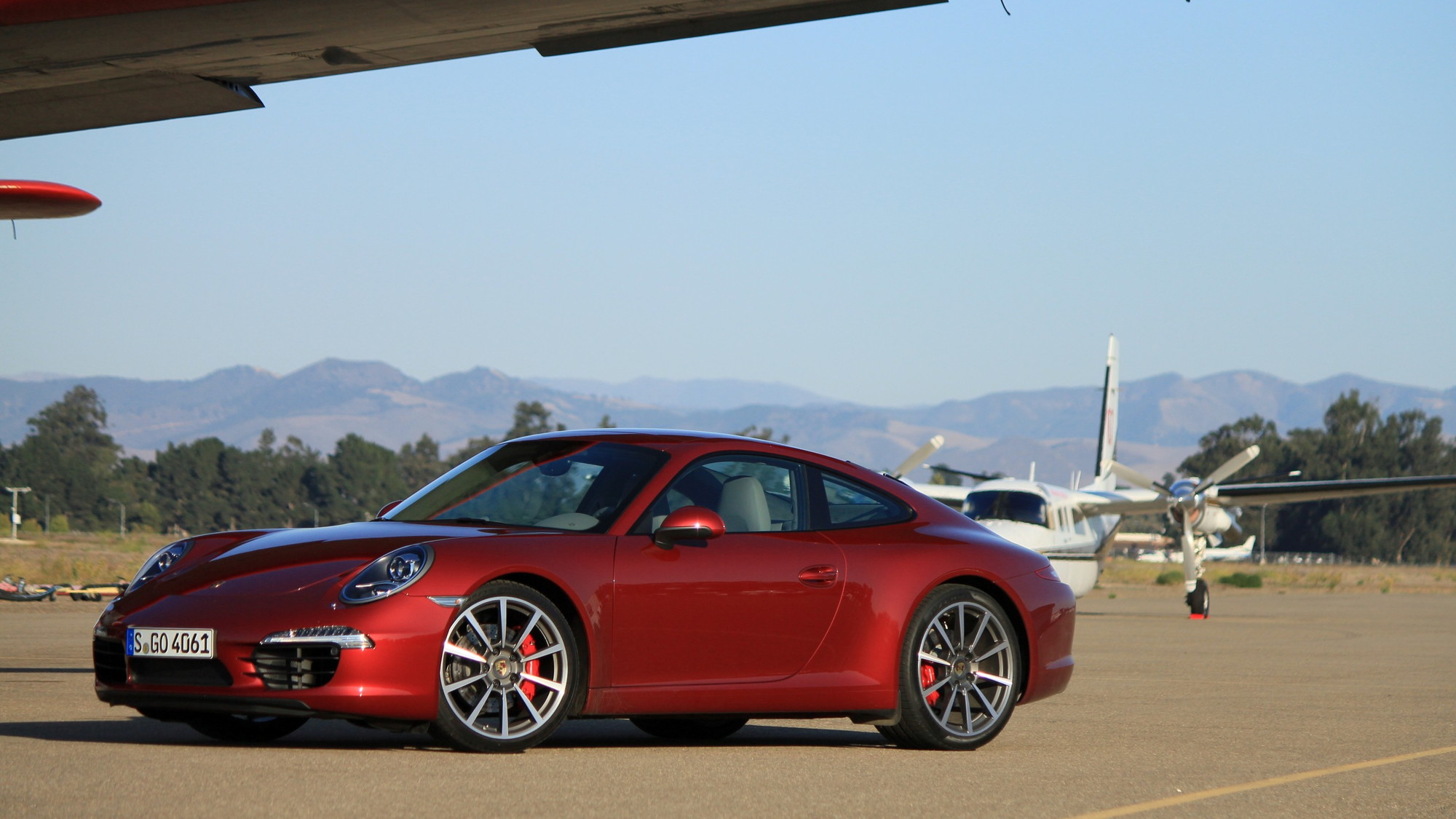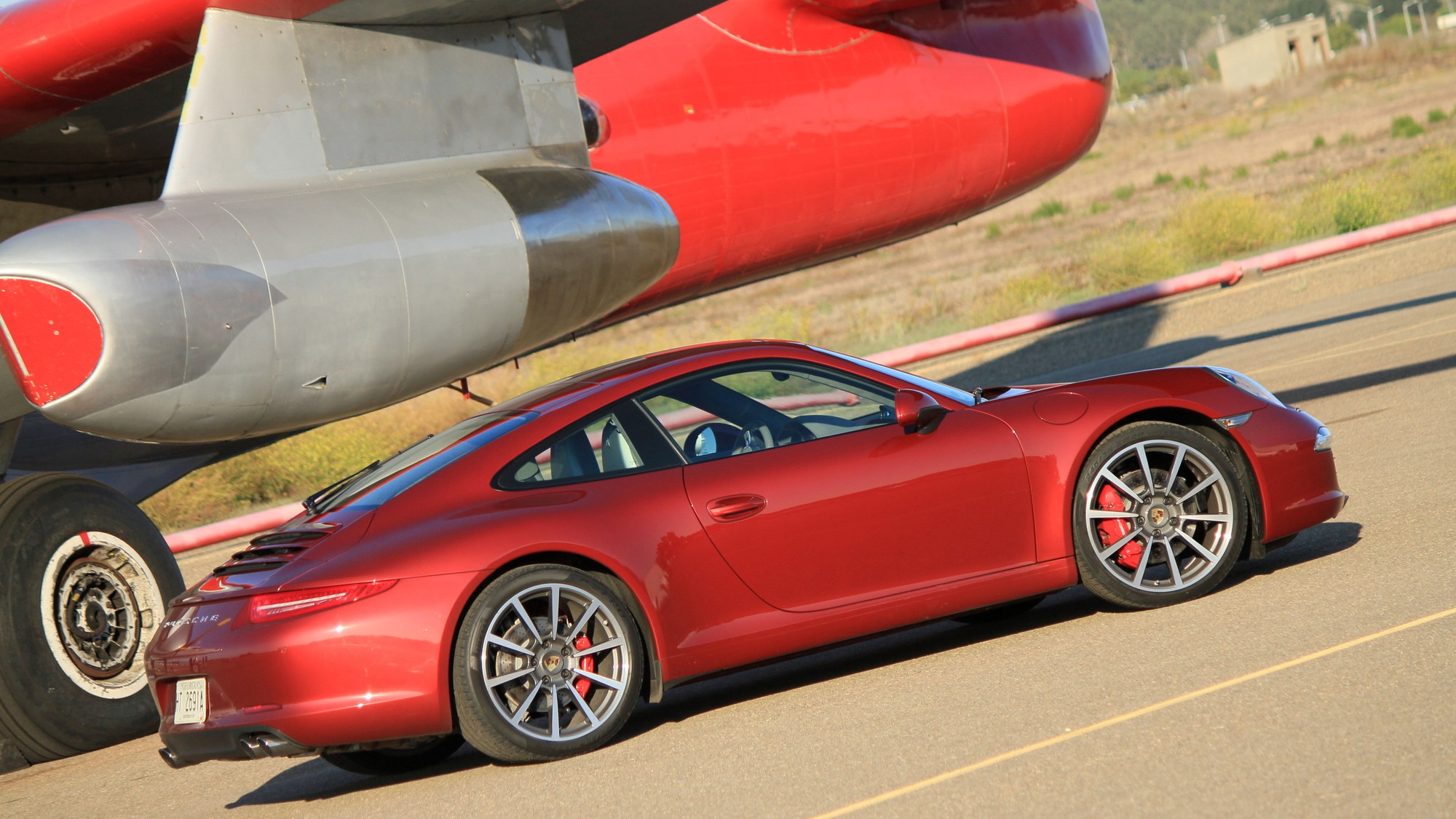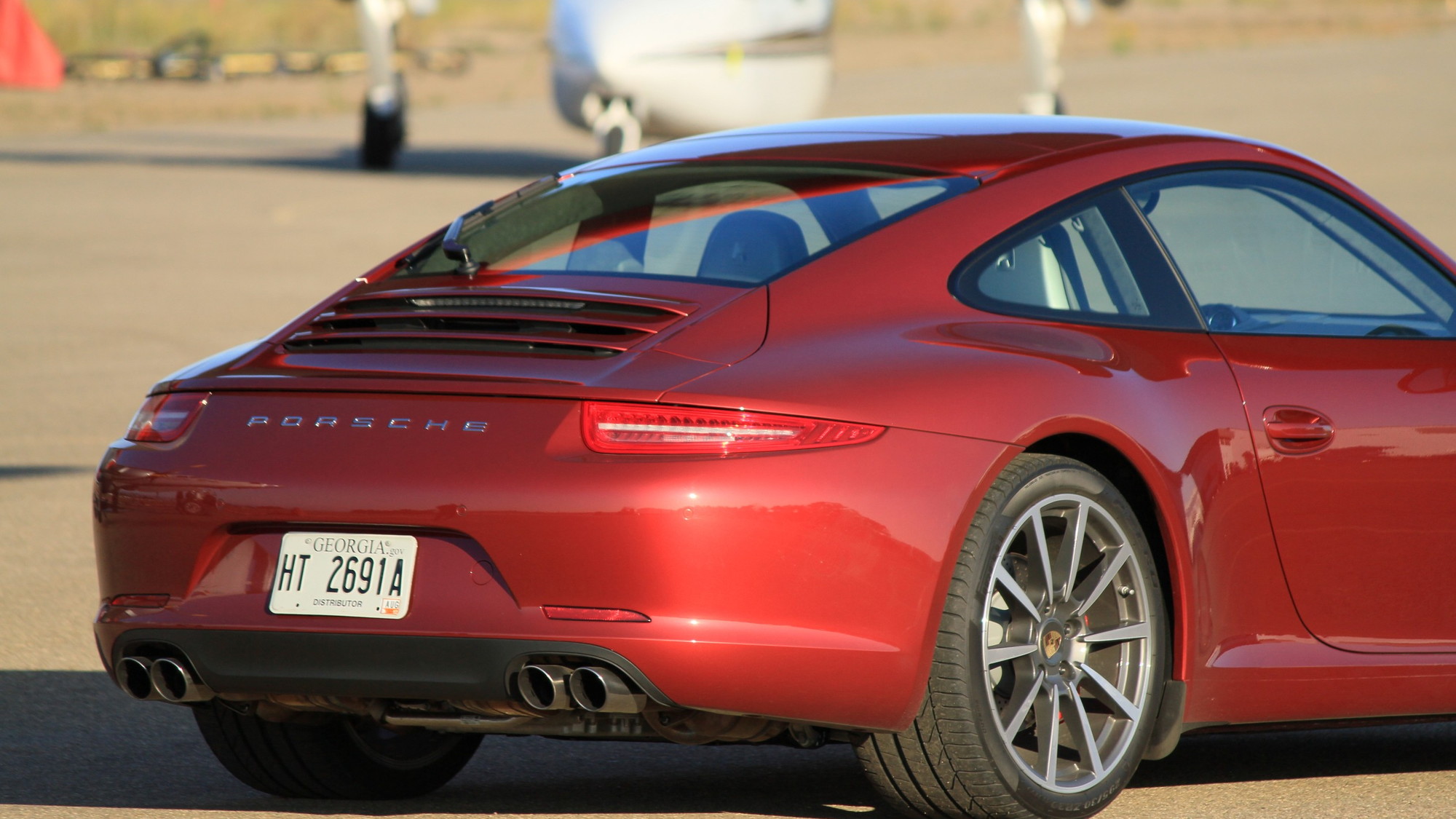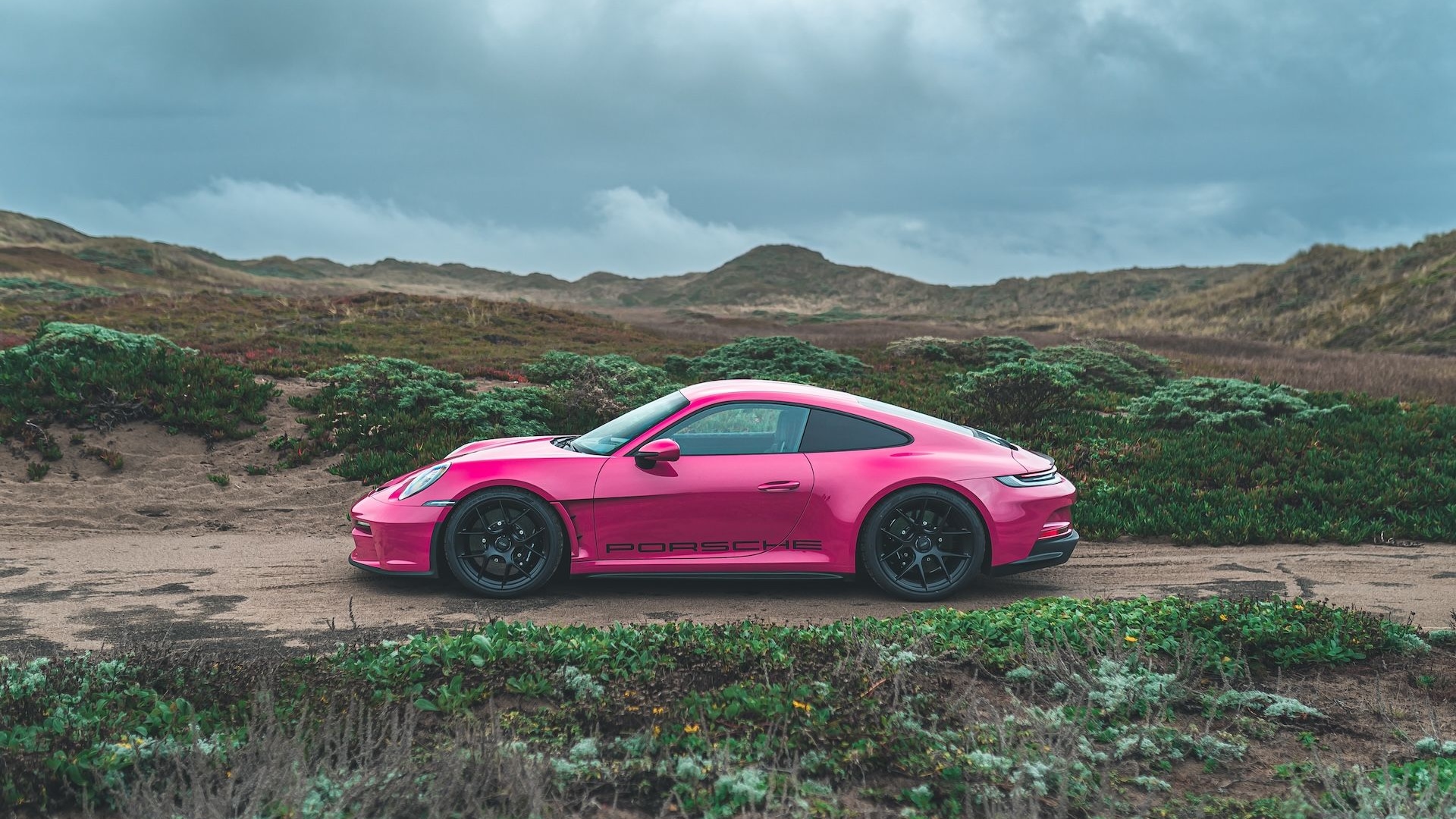Instead, it's far more informative to approach the 2012 911 as its own entity. Why? Because, simply put, it's a brilliant car, not in just one aspect, but several. Driving to work? Take the 911. Driving the canyons? Take the 911. Hitting the track? Take the 911. Picking up the kids? Well, they'd better be short-legged.
There are many subtle changes, and a few not so subtle, for the newest car to wear the 911 badge. It's longer (by 100 mm), more powerful (by 5-15 hp in Carrera and Carrera S trims, respectively), lighter (by 88 or more pounds) and, on the inside, much more like the rest of the Porsche range than its predecessor. There's even a seven-speed manual gearbox to match the tweaked seven-speed PDK.

2012 Porsche 911 first drive
We just spent a day with the 991 (and its predecessors) at the global launch event in Santa Barbara, courtesy of Porsche. After thrashing the car on a high-speed autocross course and throughout the surrounding hill country, we feel like we've come to know the car's essential character, and it's at once familiar and fresh. A worthy upgrade to the 911 legacy.
In a nutshell, the 911 is an agile, relatively light, powerful, and easily-placed sports car. It's shockingly quick in Carrera S trim with the PDK transmission, thanks in part to the easy-as-pie launch control, and the Porsche Torque Vectoring (PTV), Porsche Dynamic Chassis Control (PDCC), and even traction control have such high limits that they'll never interfere with good driving--though they do make it essentially impossible to drift. It's just about exactly what you'd expect and want from a 911.
2012 Porsche 911 2012 Porsche 911 2012 Porsche 911 2012 Porsche 911 2012 Porsche 911 2012 Porsche 911





So, to the seven-legged elephant in the cockpit: the manual transmission. Based on the PDK's fundamentals, the seven-speed manual has a slightly shorter ratio for third and a longer seventh, but it's otherwise almost identical. At first, it's weird driving a car with so many gates, but once you find a nice, rhythmic section of road, you realize it drives just like any other six-speed 'box. The seventh gear really only comes into play on the highway.
Shift into seventh and it's clear why Porsche chose to add it: engine revs drop to near-silence, fuel economy picks up, and there's still enough torque left over to power up hills without the need for a downshift.
The PDK, on the other hand, has the same number of gears, and for anything but tight autocross-style work, it's the better choice. Lightning quick, neck-snapping gear changes in Sport Plus mode meld with silky shifts when cruising. Grab the paddles yourself for a healthy dose of engaging fun, or let it do the work for you--it's surprisingly adept at figuring out how to act based on your inputs.
In either case, one of the most notable differences from the previous 911 is the quickness with which the engine revs, on both the Carrera and the S. It makes the car easy to rev-match on your own (with the manual) and it makes the computer's rev-matching almost instantaneous.
2012 Porsche 911 first drive
If you paid any attention at all to the 2012 911's official unveiling, you noticed it now features electromechanical power steering. For a car that is considered by many to be the benchmark for sports car steering feel, going to electric-assist power steering is a risky bet at best; the Internet is brimful of rants against the vague and vicious vagaries of the technology.
Fortunately, the 991 avoids most of the electrical steering pitfalls, though it doesn't avoid all of them. Feel, on the whole, is very good--for electromechanical steering. Compared to a typical electric solution, the 2012 911's steering is in an entirely different class. Compared to truly top-flight hydraulic steering, however, it leaves some on the table.
Saving fuel by not powering the steering pump when traveling straight is a great idea until you turn the wheel--then you're met with a tiny lag and surge of assist that creates what effectively feels like a notch at the 12 o'clock position. There's even a tiny bit of tolerance for steering angle before the electric assist kicks in, making for a noticeably different feel just off-center, too.
To compound the matter, Porsche offers an optional low-speed assist treatment that lightens steering even further at very low (parking lot) speeds, to make maneuvering easier. While I didn't see any reason to opt for the extra boost, I can see how some people might prefer it.
In other words, around town, the 991 steers much less like a knife-edged sports car and much more like a typical eco-conscious commuter.

2012 Porsche 911 first drive
That attention requires you to listen with your feet as much as with your hands; the 991 transfers weight fore and aft readily, and even very small inputs to the throttle or brake can have much larger impacts on where you can place the car. Get on the throttle during a turn and you'll increase your radius considerably, pushing the nose wide of the apex; lift quickly or dab the brake and you can decrease it with equal ease.
The information delivered through the wheel is just enough to let you know when you've approached either of these forks in the path forward, but it's delivered in a muted, filtered tone. If we could pick any area of the 911's performance and handling to change or improve, this would be it, but we wouldn't change it much.
With the steering figured out, the next focus becomes getting the most out of the chassis. Here, neither traction control nor PDDC will get in the way; the 991's systems are one of the only cars whose driver aids truly act as a safety net rather than an annoying intrusion. You have to be really ham-fisting the car for it to step in at all, and even then, it does only the minimum to keep the car moving well--actually aiding your driving rather than reining it in and slowing you down briefly. Even at the track, you may not find any need to disable any of the systems. They're that good.
Lighter, Stiffer, More Aluminum und Steel
Making more extensive use of aluminum has allowed the newest 911 is both lighter and stiffer than the 997. Neither weight nor stiffness are game-changers, however. They are simply incremental improvements that show their worth at the limit.
Porsche says almost 90 percent of the 991's parts are redesigned or redeveloped. The smaller, more potent engines alone account for a significant portion of the redesign, revving quickly and yet sipping fuel--a design goal aided by the lighter body and chassis.
The stiffness, on the other hand, helps get the most out of the re-tuned suspension, which keeps the 991 flatter in the turns than the 997 while ironing out the bucking Southern California pavement at the same time.
Three driver-selectable suspension modes help with that balance: normal, Sport, and Sport Plus. With all of the buttons in the off position, the 991 is smooth and pliable for the most part, and a willing commuter. Kick it up to Sport and the finer bumps will be more pronounced, though even on Sport Plus, those accustomed to taut, focused sports cars will find the ride acceptable.
With each incremental step toward Sport Plus, handling becomes sharper, throttle response more focused, and, when the magic exhaust button is pushed (it can be operated in any of the three modes) the car's throaty exhaust roars just a bit brighter. The slight crackle on overrun, and the searing howl as it approaches the 7,500-plus rpm redline, are sheer pleasure.
Auto Stop-Start, Idle on Coast: A Greener 911
The level of technology packed into the 991 is impressive from an engineering and packaging standpoint alone, but it also forms a synergistic system that helps the driver extract more enjoyment from the experience.
Auto stop-start (standard only on PDK-equipped cars) might not sound like much fun, and in truth, it's not, but it is a welcome fuel-saver when stuck in stop-and-go traffic, and it's so seamlessly implemented that you'll have no reason to complain about it. It just works.
It also works in combination with another PDK-enabled fuel-saving technology: let off the throttle while cruising around town or on the highway, and the engine will fall to idle while the car coasts. If you want to manually enable the coast function, you can just give the upshift paddle two quick tugs. Instant fuel savings, whenever you like. Get back on the gas and you'll accelerate off into the distance without the slightest hesitation. Again, it just works.
These features, along with the redesigned engines and a litany of other small tweaks enable the 2012 Porsche 911 to reach up around the 30 mpg mark on the highway, according to the company's European testing. The EPA's testeing is likely to show poorer numbers, but real-world driving will benefit immensely from the auto-stop start and coast functions.
Styled Like a 911Despite growing in length (though it's identical in overall width--only the front track is wider than the 997) and getting a host of new exterior cues, there's no mistaking the 2012 991 as anything but a 911. The classic proportions hold true, even parked next to the iconic Club Sport (a fantastic museum example was at the event, and made available for drives).
The rear of the car is particularly attractive, with athletic haunches unmarred by huge tail lights. Instead, Porsche opted for almost concept car-like slashes of light, thin and modern while still plenty bright. Up front, LED daytime running lights accent the nose.
Overall, the main impression from the 991's exterior is one of elegant simplicity: rather than slapping on every possible vent, crease, character line, and bumper lip, the designers simply let the clean, flowing curves speak for themselves. It works, and it's a stark contrast to many competing sports cars.
Inside: A Luxurious GT
As much as the 911 is still small enough to be considered a sports car (it's almost four inches shorter in wheelbase than the Nissan 370Z and weighs in at under 3,300 pounds in S trim with the PDK, its interior is more grand tourer. Luxurious leather surfaces are everywhere, complemented by tasteful aluminum accents and quality-feeling plastic switchgear.
Unlike the Panamera's busy center console and stack, the 911 is much simpler, putting just the core controls to the driving experience, HVAC, and nav/audio at your finger tips; there's no sense of clutter.
The instrument panel is as it should be: tachometer front and center, other information off to the sides. The right-most gauge of the cluster displays a rotating series of information, including a very handy summary of the navigation system's directions, making it easy to stay on course even in unfamiliar territory.
Seating is comfortable whether equipped with standard seats or the pricey sport upgrade units, though the extra cash spent on the sport seats immediately earns its way on track. The standard seats are highly adjustable, but the trimmer, firmer sport seats also have adjustable upper and lower bolsters, making it possible to get a very snug fit to really hold the driver (and passenger) in place. That makes it much easier to focus on fine, controlled inputs, which is, as I've already noted, a key component to driving the 991 well.
The rear seat isn't spacious by any means, though with sub-six-footers up front, the back is usable by smaller adults; children would be fine. With anyone much past the six-foot mark in the front seats, however, the rear seats essentially become parcel shelves.
The front-mounted trunk is spacious, deeper than you'd expect and easily capable of holding two weekend bags--perfect for a touring vacation. There's no excess of in-cabin storage, but two pop-out cupholders do offer a place to put your road-going refreshments. They're more stable and secure than most other pop-out cupholders we've seen, but they won't be grabbing a Big Gulp securely any time soon. It's a nod in the direction of American habit, but far from a full concession.
At The End Of The Day
The 2012 Porsche 911 is, without question, an excellent car, and perhaps the most well-rounded dual purpose street/track car on sale. Only Cadillac's CTS-V approaches the daily-driver-turned-racer balance of the 991, but the 911 does it at a higher, more refined level on both accounts.
Starting at $84,100 for the Carrera and $96,400 for the Carrera S, it's not a purchase lightly made, but given its overall competence at whatever it chooses to do, the sensual styling, and the fact that it is, ultimately, a true 911 (and very possibly the best ever built), it's a purchase we'd like to make.
_______________________________________









